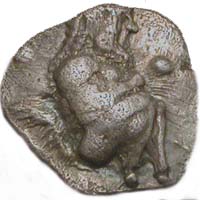Satyr

Archaic goat-like satyr on silver
fraction from Lete in Macedonia
Somewhat resembling Pan, both in appearance and in their association with the Dionysiac rituals, are these pleasure-seeking but timid deamons of the woods. Confused occasionally later with Selinos, the Satyr's artistic representations varied from early, more goatlike-versions, to the largely anthropomorphic ones, exemplified by the classic sculpture of master Praxiteles. Yet, some of the more memorable renditions are those found on archaic coins of Thasos, with running Satyrs, sometimes "ithyphallic" (sexually aroused), in the charming scene where one tries to run away with a protesting nymph.
Some satyrs achieved considerable prominence - like in the case of Marsyas, known for his legendary musical competition with Apollo (which he lost, naturally, and with grave consequences), and represented on coinage in both Greece and Rome. Although most accounts state that he held his own against Apollo in his musical challenge (being even favored by the Muses), in the end the wrath of his divine opponent was severe; he was skinned alive, and is shown often carrying around his skin in the form of a wineskin. However, in Roman times Marsyas also became, though associations with Liber Pater and Libertas, a symbol of civic freedom, and a prominent statue to that effect was erected in the Forum Romanum, and approximately replicated in a number of republican (e.g. under moneyer L. Censorinus) and provincial (e.g. in Corinth) issues.
Search for coins showing satyrs.
